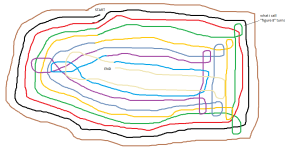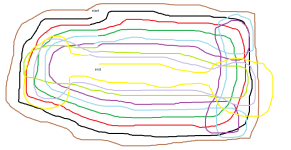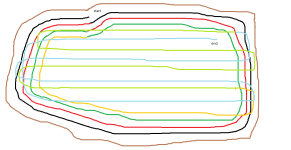it just like mowing a regular yard with a finish mower. in a sense with some extra "tricks in it"
i hate making "sharp corners" and if forced will start making "figure 8" style corners when finishing mowing the yard.
for a hey field, or just any field for that matter, "compaction" of the ground is an issue. so if you can make all your TURNS at the edge of a field. vs in the middle of it some place. then you know were your compaction is, and able to say take a couple extra passes with a plow, disc, "insert what ever implement" to loosen up the compaction. before planting. vs having to work entire field multi times due to compaction.
once you cut the hay, then you need to come back and bail it / deal with it some how. if you are using a tractor with square bailer behind that, and then a hay wagon behind that. trying to do "figure 8" style turns. on sharp corners results in VERY large turns. in order to keep the bailer input aligned. and you may end hitting the fence.
tractor + large round bailer. you are more likely able to make smaller tighter turns than square bailer and hay wagon behind it. but again you are forced to take a slight larger turn than if you just had the tractor out there "think riding lawn mower and mowing your yard"
EXAMPLES:
this might be a mowing pattern i might use for a riding lawn mower,
1. being able to go "round and around" first few passes around the yard,
2. and as i get closer and closer to the center i begin to start making figure 8 turns.
3. as in get down the the final narrow strips. i end up making U turns
4. and finally at end of the strip i end up turning out away from the strip and making a large U turn almost a a full 360 degree turns to finish off the final couple passes in the very center.

tractor + square bailer + hay wagon
1. again "round and around i go" for first few passes.
2. as i get closer into the center i begin getting sharper corners i can no longer turn with. forcing "much larger figure 8 turns" vs riding lawn mower above.
3. like above U shape turns but larger U shape turns than above
4. full circle nearly full 360 degree turns to get the final row.

strip mowing/bailing/etc...
1 again like above "round and around i go" BUT i go around enough times i can make larger U turns around the end / edge of the field.
2. once i get enough pass around and around i go, so i have room to make those larger turns at the ends, i begin doing strips.
3. instead of travel 1/4 mile from end to end, to treat field as a single strip. field is broken up in multi strips. so i can do every other strip.
4. this keeps all the main "turning" and compaction of the soil at the ends were i know things will be, you need to remember...
4a. tractor + cutter (compaction one)
4b. tractor + wind rowing cut hay (compaction 2)
4c. tractor + bailer (compaction 3)
4d. wagon if square bailer OR tractor and moving round bails off of field. (compaction 4)
were do you want your compaction every place and randomly through out the field? OR at designated ends of the field?

with folks notation of going back and doing an X a couple times to clean out the corners can work as well.
every shape of field is different "length and width" but also any obstacles you might have to get around and when / were a figure 8 style corner may come up vs U turns to nearly 360 degree turns. to "lazy turns in X style doing, were ya don't try and make a 90 degree sharp turn but leave a patch in corners, so you are not having to make as sharp of a turn. and going back with some X style doings...
what works best hard to say. there is always an easy approach, and always a harder approach, what is best for the field / soil can be different as well.


